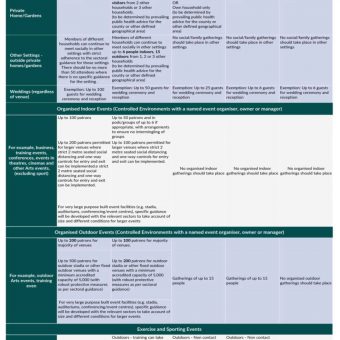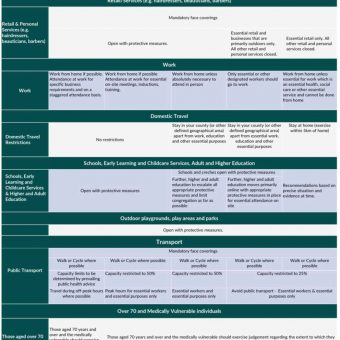Living with COVID-19 is a cross-government approach to managing the pandemic for the coming months.
We have come a long way and made a lot of progress in managing COVID-19 in Ireland. COVID-19 looks to be here with us for some time, and this numbered framework of levels is being put in place in order to manage the pandemic in the medium-term.
This approach is about living alongside the virus with as little interruption to people’s lives and economic activity as is possible at any one time.
Each Level corresponds to the measures that will be in place in that region as a result of the pattern and progress of COVID-19 in a particular region at a particular time.
This is a framework to help guide decision-making by each one of us individually and all of us collectively as a society. The aim is to facilitate living, working and social interaction to the greatest extent possible while COVID-19 is still with us.
Over the coming months, our objective is to suppress the virus to the lowest possible level so we can live our lives to the greatest possible level.
Together, we need to reduce the opportunity for the virus to spread from person to person. We need to do this individually and collectively so that we can continue to prioritise protecting the most vulnerable, our healthcare system and our education services.
We know that widespread restrictions are difficult on us all, individually and as a society. For this reason, this numbered Level framework introduces measures that are targeted and proportionate, focused on areas of most concern.
‘Living with COVID-19’ is a framework to provide clarity on what restrictive measures are appropriate around the country based on the pattern and progress of COVID-19 in a particular area at a particular time.
The system is communicated through a numbered system of alert Levels (from 1 to 5) with:
- Level 1 being the lowest and having the least amount of restrictive measures in place
- Level 5 being the highest and having the most restrictions in place
These Levels are applied to each county based on the current COVID-19 situation in each county. The Level in your area is determined by multiple factors, including the 14-day incidence rate of COVID-19 cases and other key indicators including hospitalisation, admissions to Intensive Care Units (ICU), community transmission rates and the profiles of those with the virus.
The National Public Health Emergency Team (NPHET) reviews a number of disease indicators on an ongoing basis. These include:
- the 14 and 7 day incidence per head of population
- the rolling 5-day average of cases by county
- the number and location of clusters of cases
- the level of cases in nursing homes and other residential healthcare settings
- the number of admissions to hospital and ICU
- the number of deaths
Based on their analysis of the disease, NPHET will make recommendations to the government on the appropriate Level on a county or national basis, who will make a decision and announcement to those concerned.
Depending on the behaviour of the disease, different counties may be at different Levels. For example, the measures introduced in Kildare, Laois and Offaly in August would have put them at Level 3, while all other counties were at Level 2.
COVID-19 spreads when individuals and groups come into close contact with one another, enabling the virus to move from one person to another. COVID-19 is infectious in a person with no symptoms, or for the period of time before they develop symptoms. For this reason, we are all asked to be extra careful when socialising and working with others. For now, we must act like we have the virus to protect those around us from infection.
We use households as a way to define who should socialise together because everyone in a household lives together, are close contacts of each other and are considered to have the same risk as each other of having COVID-19.
The number of people allowed to gather in different scenarios in the Government Framework are based on a review of international practice and the judgment of public health experts. It seeks to balance the risks of different types of gatherings against the desire to allow normal activities to proceed in so far as possible.
The minimum number of 6 people gathering aims to facilitate socialising within close family or friendship groups, with ceilings placed on large gatherings to minimise spread of the disease and the burden on contact tracing in the event of an outbreak.
Socialise safely and within the capacity limits. These various limits in the Levels are all designed to reduce the number of households mixing with each other and cut down the virus’s chances of spreading into more homes.
The numbers should not be considered a target – they are the maximum recommended number. It’s always safer to meet less people, less often, for less time. If we do this, we have a better chance of keeping to the lower Levels in the Framework, and continuing to keep businesses, schools, and healthcare services open, while also protecting the most vulnerable.
There are exemptions for weddings and funerals at all Levels. This is due to the particular significance these events have for individuals and society more broadly.
COVID-19 spreads quickly in particular settings and areas, and outbreaks and clusters can emerge rapidly in towns and counties. For this reason, there may be a need to ensure people do not travel far from where they live to limit the virus’s chance of spreading into other areas from an affected region.
Across all Levels in the plan, it is recommended that to minimise the spread of the virus people who can work from home should do so.
There is detailed guidance for employers and employees in the Return to Work Safely Protocol.
You should walk or cycle where possible.
If you must use public transport, please be aware that there may be capacity restrictions to allow for physical distancing.
Face coverings are mandatory on public transport of all types. Face coverings help to reduce droplets that arise from speaking, breathing, shouting, sneezing or coughing, and so on. These droplets spread COVID-19 from person to person. A face covering is recommended in settings where maintaining physical distance is difficult. They are thought to reduce the transmission of COVID-19 in people who are unaware they have the virus. If you are symptomatic, you should stay at home and call your GP.
COVID-19 has a distinct presentation and impact on those over 70 or with certain underlying medical conditions.
Older adults are more likely to already have underlying conditions such as cardiovascular disease, diabetes, or respiratory illness — comorbidities that are known to raise the risk of severe COVID-19 and COVID-19-related death. In addition, a likely weaker immune system makes it harder for older adults to fight off infection.
For this reason, in Level 1 this vulnerable group is asked to exercise individual judgement, stay at home as much as possible while also remaining aware of the risks of socialising with others while COVID-19 is circulating.
In Levels 2 to 5 older and medically vulnerable are advised to avoid public transport, shop during designated hours and limit their social contacts to a very small number of people, for short periods of time, while remaining physically distanced.
There is no risk free scenario but a ‘controlled environment’ is one where the number of people and the ways that they interact can be actively managed. The owners or organisers can control the number of people coming in and out, and there is space to physically distance. Controlled environments are those where the number of people present and the ways that they interact can be controlled, where there is a recognised organiser, where people are seated and generally remain in that same seat for the event, physical distancing, hand hygiene can be monitored, and contact tracing can be facilitated. For example, a sports club AGM, watching indoor sport, youth club meetings, AA meetings, conferences, training events, theatre performances.
These events must be pre-organised with an identified organiser to ensure people are seated, physical distancing, hand hygiene can be monitored and contact tracing can be facilitated. Capacity for indoor events is smaller than outdoors, because we know COVID-19 spreads more in enclosed, unventilated or confined spaces.
Attention should be paid to appropriate behaviour before and after events – there is increased risk of COVID-19 transmission when sharing cars to and from events, or in socialising around events.
These events must be pre-organised with an identified organiser who ensures physical distancing can be maintained. Capacity for outdoor events is larger than indoor, due to evidence that indicates COVID-19 spreads less easily out in the open air.
Attention should be paid to appropriate behaviour before and after events – there is increased risk of COVID-19 transmission when sharing cars to and from events, or in socialising around events. But it is important to note that outdoors isn’t completely risk-free. There are still opportunities for close contact and there are particular risks associated with activities surrounding the event, for example transportation to/from, entry/exit – these are points from there is a particular risk of congregation.
It is recognised that sport has a unique position within society and also plays a role in physical and mental health. Individual exercise is recommended at all times during the pandemic. As with other events, exercise is considered safer if done outdoors.
Details of how to protect yourself during exercise, with measures such as not sharing equipment or water bottles, travelling separately to the venue, and more, are at www.sportireland.ie/covid19.
Based on experience so far in terms of compliance to public health advice, religious services will go ahead in the coming months with agreed capacity limits and a close adherence to other public health guidance in respect of distancing, cleaning and ventilation.
Protective measures such as a maximum capacity to allow 2 metre distancing, one-way traffic within the venue, removal of communal prayer items and more, are in place.
COVID-19 is highly contagious and spreads when individuals and groups come into close contact with one another, enabling the virus to move from one person to another.
All places of worship require a plan to limit the spread of the virus among their congregations.
Museums and galleries are controlled spaces, with protective measures such as a maximum capacity to allow 2 metre distancing, the ability to control the amount of people in a space at any one time, one-way traffic within the venue, staff wearing face coverings, and more, in place.
Cafes and restaurants are considered controlled environments, in which seating of patrons, distancing between customers, facilitating contact tracing, hygiene protocols and other protective measures can be implemented. However, if the disease is circulating at a high level, it may be necessary to reduce social congregation in more settings. In this case, restaurants and cafes would move to being takeaway or delivery only services.
Pubs/bars pose a particular risk to the spread of COVID-19, as alcohol can have a disinhibiting effect on people and impair judgement, and however well-intentioned people are, it can impair awareness of and ability to comply with social distancing and hygiene/respiratory advice.
The physical characteristics and typical atmosphere in pubs also contribute to risk, as loud atmospheres can increase droplets emitted as people raise their voices to be heard. Pubs/bars can be small spaces with poor ventilation.
Based on international evidence, one of the measures NPHET has recommended to suppress the spread of the COVID-19 is to limit the amount of time that people come together in groups indoors to reduce the length of the social contact and minimise the risk of the spread of the infection.
There is a public health distinction drawn between ‘wet’ pubs and pubs operating as restaurants.
Because of the highly contagious nature of COVID-19 and the fact that it spreads where people are close together and maybe letting their guard down accidentally, you can only buy or serve alcohol along with a substantial meal at present.
Protective measures such as staff face coverings, signage, hand sanitiser, regular cleaning of hard surfaces, customer details recorded for contact tracing process, and more, are in place.
Essential retail outlets like supermarkets will remain open at all Levels of the plan.
Face coverings are mandatory in a range of indoor commercial settings, including shops and supermarkets.
Face coverings help to reduce droplets that arise from speaking, breathing, shouting, sneezing or coughing, and so on. These droplets spread COVID-19 from person to person. A face covering is recommended in settings where maintaining physical distance is difficult. They are thought to reduce the transmission of COVID-19 in people who are unaware they have the virus. If you are symptomatic, you should stay at home and call your GP.
Face coverings are not mandatory in banks, post offices or credit unions. These are controlled environments where social distancing for members of the public should be achievable. There are also security requirements in terms of ensuring the identities of people entering a financial institution are apparent.
In relation to whether workplaces can hold meetings in a hotel for conferences or other large meetings, certain principles apply:
- meetings and training should take place online if at all possible
- where it is deemed essential to have business/work related activities in person, this should happen in line with the Return to Work Safely Protocol. This includes physical distancing of 2 metres. If that is not possible face coverings should be used
- physical face to face meetings should be kept as short as is possible consistent with the aim of the meeting
- the numbers attending should be kept to an absolute minimum. While capacity will depend on the venue and the ability to physically distance and ensure other protective measures are in place, it should be noted that an upper limit of 50 has been recommended by NPHET for other types of indoor gatherings
- communication and preparation ahead of the meeting should endeavour to reduce the actual time required at the actual meeting
- if possible increase ventilation in the meeting facilities
There are legal Regulations in place to reduce the numbers of people gathering indoors.
Work and educational events are not covered by these Regulations and such an event can take place in a hotel or other large meeting place.
The principles for work meetings apply to a maximum of 50 people and should be considered by those planning business events.
Evidence from the first wave of COVID-19 appears to indicate that children are not as susceptible to COVID-19 infection as adults. Furthermore, a recent review of available international evidence by HIQA indicates that children do not seem to play a major role in disease transmission.
It is recognised that education has a vital role in the development of children and young adults, and also within our communities and society at large.
Based on the understanding of this evidence, as part of the ongoing response to managing COVID-19 a stepwise approach to managing the risk of disease transmission in educational and childcare facilities will be taken, based on local public health risk assessment.
Rather than closing these facilities en masse, it may be possible to limit closures to individual facilities and confine an outbreak to those facilities experiencing outbreaks using robust and rapid testing, contact tracing, and isolation.
The safe continuation of education and childcare is a key priority and schools and creches will remain open in Levels 1 to 4, with protective measures in place. Recommendations on Level 5 will be based on the precise situation and evidence at time.
Parks, play areas and playgrounds are outdoors, and so the relative risk of transmission of COVID-19 is lower than in an indoor environment. Additionally, these provide vital mental and physical health support for children and families. They remain open at all Levels, with protective measures in place.
COVID-19 is highly contagious and when it is circulating at high levels within the community, there is an increased risk that it will enter into nursing homes and other long-term residential care facilities. Those in these settings are often very vulnerable to this virus and its effects, as well as the settings themselves posing risks in terms of infection control and prevention.
In order to reduce the risk of COVID-19 being transmitted to vulnerable populations, it may be necessary to reduce the number of visitors to long-term residential care facilities at certain critical times.




